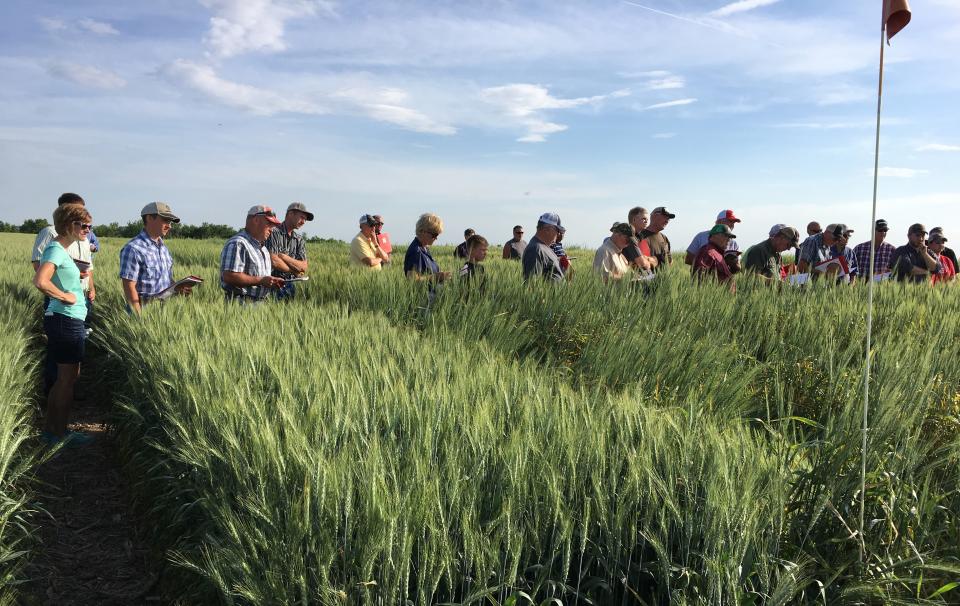
Research Suggests Changes in Two Wheat Practices Could Lead to Increased Yield
Fine-tuning wheat production practices such as seeding rate and N application timing and selecting a mix of varieties for a location could significantly improve yield and end-use quality of winter wheat in Nebraska, based on results of University of Nebraska research.
Studies conducted on rainfed wheat at the Agronomy Research Farm (ARF) near Lincoln and at the High Plains Agricultural Laboratory (HPAL) near Sidney in 2014 and 2015 found that increasing wheat seeding rate up to twice the local recommended rate and applying N fertilizer in season at the flag leaf stage increased grain yield, net return, and improved multiple grain quality parameters of six widely grown Nebraska wheat varieties.
The research was conducted in 2013-2014 and 2014-2015 to determine the effects of three seeding rates, and flag leaf top-dressed N on the yield and end-use quality of six widely grown winter wheat varieties in Nebraska. The six winter wheat varieties—Freeman, Millennium, Overland, Pronghorn, Robidoux, and Settler CL—were tested at half, standard, and twice the recommended seeding rates for each site. The standard seeding rates are 60 lb (1,020,000 seeds) per acre at the ARF and 44 lb (753,000 seeds) per acre at HPAL. ARF plots were planted in October with 30, 60, or 120 lb (510,000, 1,020,000, or 2,040,000 seeds) per acre. Plots at HPAL were planted in September with 22, 44, or 88 lb (376,000, 753,000, or 1,505,000 seeds) per acre. Moreover, half of the research plots received only 50 lb/ac N applied at planting (current recommendation); the other half received an additional 30 lb/ac N top-dressed at the flag leaf stage.
It is vital to mention that the stage of growth when N was applied is not the key point here, rather applying N when plants need it most (during late stem elongation) so as to effect increased canopy area and possibly extend the flag leaf area. Flag leaf area is known to significantly affect wheat grain fill and the length of the grain-filling period.
Results from Changing Two Practices
Doubling the Wheat Seeding Rate
Grain yield increased with increased seeding rates during both years at both test locations (Figure 1). In 2014, doubling the seeding rate increased grain yield by 5% at ARF and 9% at HPAL. Estimated net return increases in 2014 were, respectively, $7/acre at ARF and $33/acre at HPAL. In 2015, doubling the seeding rate increased grain yield 13% at ARF; the net return increase was $8/acre. Doubling the seeding rate at HPAL in 2015 did not result in increased yield, but did result in a net loss of $4/acre. This loss is attributed to an unusually high leaf disease severity at HPAL that resulted in almost a 50% drop in yield.
Reducing the seeding rate below the current recommendation resulted in decreased grain yield and a loss of net returns at both locations and years.
Applying In-Season N Fertilizer
Applying N fertilizer at the flag leaf stage increased grain yield and improved end use quality characteristics of the grain.
In 2014 wheat yield increased by 9% both at the ARF and HPAL. The value of this increase to net returns was estimated to be about $41/acre at the ARF and $39/acre at HPAL. In 2015 yields were reduced significantly due to severe disease incidence at both sites, irrespective of whether in-season N was applied at the flag leaf stage.
Grain protein dropped in response to applying N at the flag leaf stage, contrary to researcher expectations; however, most baking quality characteristics were improved.
References
More detail on this research is available in these journal articles:
Seeding Rate, Genotype, and Top-dressed Nitrogen Effects on Yield and Agronomic Characteristics of Winter Wheat by Madhav Bhatta, Kent M. Eskridge, Devin J. Rose, Dipak K. Santra, P. Stephen Baenziger, and Teshome Regassa in Crop Science, 2017.
Bhatta et al. 2017. Genotype, Environment, Seeding Rate, and Top-Dressed Nitrogen Effects on End-Use Quality of Modern Nebraska Winter Wheat by Madhav Bhatta, Teshome Regassa, Devin J Rose, P Stephen Baenziger, Kent M Eskridge, Dipak K Santra, and Rachana Poudel. Journal of the Science of Food and Agriculture.
Online Master of Science in Agronomy
With a focus on industry applications and research, the online program is designed with maximum flexibility for today's working professionals.
